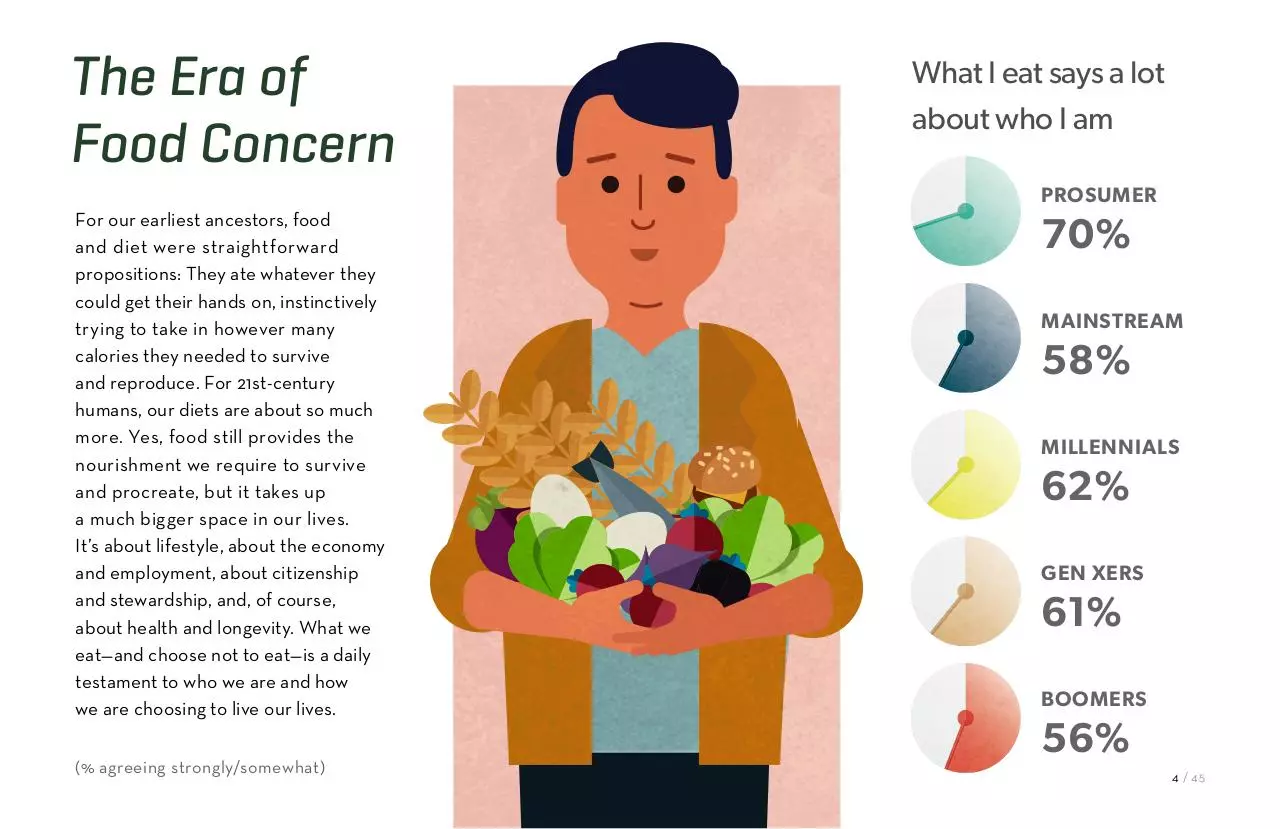D8 FOOD DIGITAL (PDF)
File information
This PDF 1.7 document has been generated by Adobe InDesign CC 2015 (Macintosh) / Adobe PDF Library 15.0, and has been sent on pdf-archive.com on 25/07/2016 at 23:05, from IP address 208.184.x.x.
The current document download page has been viewed 494 times.
File size: 3.71 MB (46 pages).
Privacy: public file





File preview
EATERS
DIGEST
THE FUTURE
OF FOOD
Table of Contents
3
ABOUT THE STUDY
4
THE ERA OF FOOD CONCERN
10
TREND 1: ME, MY BODY, AND THE PLANET
20
TREND 2: LOCAL IS THE NEW ORGANIC
25
TREND 3: RAW PLEASURE
29
TREND 4: #FOODPORN IS A TOTAL TURN-ON
36
TREND 5: SOCIAL EATING IS BACK
41
FOOD RESONATES DIFFERENTLY BY CULTURE
44
10 FOOD TRENDS ON OUR RADAR FOR 2016
ABOUT THE STUDY
In February 2016, Havas Worldwide
partnered with Market Probe
International to survey 11,976 men
and women aged 18+ in 37 markets:
Argentina, Australia, Belgium, Bosnia,
Brazil, Cambodia, Canada, China,
Colombia, Croatia, the Czech Republic,
Estonia, France, Germany, India, Ireland,
Italy, Japan, Laos, Latvia, Lithuania,
Mexico, Myanmar, the Netherlands,
The survey sample
was made up of 20%
leading-edge PROSUMERS
and 80%
the Philippines, Portugal, Russia,
Saudi Arabia, Serbia, Singapore,
Slovenia, South Africa, Spain, Turkey,
the United Arab Emirates, the United
Kingdom, and the United States.
MAINSTREAM
consumers.
Who are Prosumers?
Prosumers are today’s leading influencers and market drivers—and they’ve been a focus
of Havas Worldwide studies for more than a decade. Beyond their own economic impact,
Prosumers are important because they influence the brand choices and consumption
behaviors of others. What Prosumers are doing today, mainstream consumers will likely be
doing 6 to 18 months from now. Learn more at mag.havasww.com/prosumer-report/.
MILLENNIALS
GEN XERS
BOOMERS
ages 18–34
ages 35–54
ages 55+
Prosumer and mainstream respondents
are segmented into the above generations.
Note: Some figures do not add up
to 100 percent due to rounding.
3 / 45
The Era of
Food Concern
What I eat says a lot
about who I am
PROSUMER
For our earliest ancestors, food
and diet were straightforward
propositions: They ate whatever they
could get their hands on, instinctively
trying to take in however many
calories they needed to survive
and reproduce. For 21st-century
humans, our diets are about so much
more. Yes, food still provides the
nourishment we require to survive
and procreate, but it takes up
a much bigger space in our lives.
It’s about lifestyle, about the economy
and employment, about citizenship
and stewardship, and, of course,
about health and longevity. What we
eat—and choose not to eat—is a daily
testament to who we are and how
we are choosing to live our lives.
(% agreeing strongly/somewhat)
70%
MAINSTREAM
58%
MILLENNIALS
62%
GEN XERS
61%
BOOMERS
56%
4 / 45
I trust the food industry to provide consumers with healthful food
(% agreeing strongly/
somewhat)
46%
36%
38%
36%
33%
PROSUMER
MAINSTREAM
MILLENNIALS
GEN XERS
BOOMERS
For marketers, there would seem to be an infinite range of ways
to build meaningful connections between consumers and food
brands. After all, food is a highly personal product that must be
consumed by every person on the planet multiple times per day.
And yet those opportunities to build connections are largely being
missed. Whereas in the past the food industry created beloved
brands that accompanied people throughout their lives, today the
category is rife with distrust and confusion. Many people seeking
the benefits of smarter food choices don’t feel confident in the
products—or information—the major food companies provide.
In our newest global study, fewer than 4 in 10 respondents said
they trust the food industry to provide them with healthful food.
And levels of trust are even lower in many countries—dipping to
28 percent in Belgium and Japan, to around 20 percent in France,
Germany, Lithuania, and Russia, and to a dismal 9 percent in
the Czech Republic. The industry is also struggling to meet the
broader emerging needs of people and the planet. While Google
strives to provide universal Internet access and help with the
migrant crisis, food brands are still talking about snacking. Some
smaller brands are responding to the world’s problems, but the
giants seem stuck in self-protective mode—for the most part
responding to criticisms (e.g., marketing to children, excess sugar
and salt) rather than taking the lead in driving meaningful change.
5 / 45
In two of our previous Prosumer Reports, Building Brands That
Matter and Project: Superbrand, we saw that brand equity is
driven by quality and trust. It comes as no surprise then that so
many major food and beverage brands have been facing a steady
decrease in their attractiveness to consumers. In 2015, for the first
time in decades, McDonald’s closed more stores than it opened
in the US, as it struggled to keep up with new competitors and
changing tastes. Kellogg’s has been experiencing sales declines
for a number of years, as health– and time–conscious consumers
have begun to avoid the cereal aisle. And these brands are far
from alone: It’s estimated that the top 25 US food and beverage
companies have lost an equivalent of $18 billion in market share
since 2009. We’re seeing a similar pattern of decreasing brand
equity in Europe as well.
Further evidence of this loss of equity: We asked respondents
to rank six criteria (price, place of origin, nutritional value,
ingredients, visual appeal, brand name) in terms of how important
each is in their food-purchasing decisions. Brand name came in
dead last, with just 13 percent of respondents ranking it first or
second in importance. Fewer than 1 in 4 included it among their
top three criteria. What matter now are nutritional value and
ingredients—and it’s clear that people no longer feel they can
assume a product is good for them simply because of
the name attached to it.
Please rank each of these criteria in
terms of how important it is in your
food-purchasing choices.
PERCENT RANKING AS #1:
30%
8%
NUTRITIONAL
VALUE
PLACE OF
ORIGIN
26%
7%
PRICE
VISUAL
APPEAL
23%
6%
INGREDIENTS
BRAND
NAME
PERCENT RANKING AS #1 OR #2:
52%
NUTRITIONAL
VALUE
20%
PLACE OF
ORIGIN
52%
17%
INGREDIENTS
VISUAL
APPEAL
45%
PRICE
13%
BRAND
NAME
6 / 45
Grocery shoppers have become conditioned to questioning
food claims. And who can blame them? That spaghetti and
meatballs dinner you ate? Judging from news headlines over
the past couple of years, the “beef” in the meatballs may
actually have been horsemeat, the “Italian olive oil” you used
may not have been from Italy or even predominately olive oil,
and the “Parmesan cheese” you sprinkled on top may actually
have been wood pulp. Bon appétit!
A brand’s claims mean little now if they can’t be independently
verified. Popular products marketed as “all natural” have
been found to contain everything from artificial preservatives
and thickening agents to potentially carcinogenic chemicals.
Unclear labeling, regulatory loopholes, and duplicitous
practices have turned many consumers into food detectives—and
BS detectors—and it’s beginning to have an impact. As shoppers
pay more attention to packaging labels, they’ve started pressuring
companies to remove unpopular ingredients. And more and
more brands are responding to the pressure, regardless of
whether they agree that an ingredient is unsafe. Euromonitor
International reports that the use of high-fructose corn syrup
in packaged foods and drinks fell 17 percent in North America
between 2009 and 2014, not because of any proven health
hazard but simply because consumers decided they didn’t
want it in their diets.
(% agreeing strongly/somewhat)
Consumers’ new role as food “checkers” and their proven
influence on food companies have created a real sense of
empowerment. Eight in 10 Prosumers globally—and two-thirds
of mainstream consumers—now believe consumers should
have the power to change food policies. This reflects an
erosion of trust in governmental oversight, as well as the
increasingly proactive nature of the modern shopper.
Consumers should have the
power to change food policies
80%
PROSUMER
66%
MAINSTREAM
7 / 45
Big Food as
Public Enemy
As people grow more concerned about what’s in the products
they eat, we’re seeing the category shift to some extent away from
emotion-based purchases (impulse buying) to a more rational and
studied approach. We’re also seeing an emerging paradox that
should be of great concern to food companies: Even as people
are becoming increasingly obsessed with food, their relationships
with food brands are weakening. Rather than being lauded as
the providers of food innovations and cherished products, food
companies are being blamed for major health issues, including
rising rates of obesity, diabetes, and cardiovascular disease.
Food concerns aren’t simply a personal issue, they’re a social one.
Nearly three-quarters of our respondents believe that junk food
and unhealthful diets are among the greatest threats facing our
species. We’ve seen entire civilizations, such as the Maya and
the Sumerians, disappear because their mistreated ecosystems
could no longer support their populations. So it’s not too much
of a stretch to believe that our poor diets and the harm modern
food industries are inflicting upon our planet are cause for
concern.
Junk food/unhealthful diets are one of
the greatest threats facing our species
PROSUMER 77%
MAINSTREAM 71%
(% agreeing strongly/somewhat)
8 / 45
What does this mean for the future of food? It means an evolving
relationship in which people will be asserting more power—
individually and collectively—over the foods and beverages
they consume. It means food will become further politicized,
as governments seek to regulate (and tax) unhealthful products,
as the battles over ingredient labeling continue, and as more
people seek to align their diets with their sociopolitical views.
And it means food producers and manufacturers will need to
enter into a new form of partnership with consumers—or risk
being replaced on shopping lists.
This report covers five primary trends:
TREND 3: RAW PLEASURE
TREND 1: ME, MY BODY, AND THE PLANET
Health, food, and the environment have always been interconnected,
but those links became increasingly obscured as more people lived
far removed from agriculture. As the consequences of the modern
diet become better understood, people are taking a more holistic—
and proactive—view of food and its impact.
TREND 2: LOCAL IS THE NEW ORGANIC
Over the past decade, calls to “buy local” have intensified,
as new consumers seek to support nearby producers and
merchants and keep retail profits closer to home. In the
food category, “buy local” is about optimizing freshness and
health, protecting the planet, and feeling closer to the land.
In our increasingly artificial world, truly natural products
have become almost an exotic indulgence. For the new consumer,
eating nature-made, unadulterated foods is more than a pathway
to health. It confers pleasure and even a sense of status.
TREND 4: #FOODPORN IS A TOTAL TURN-ON
From obsessively Instagramming their meals to marathoning
food TV, new consumers—millennials especially—are enthusiastic
foodies. That’s having an impact in an array of categories, including
media and travel.
TREND 5: SOCIAL EATING IS BACK
After decades spent speeding up food preparation and
perfecting the art of eating on the run, people are seeking
a return to the romance and traditions of communal dining.
9 / 45
Download D8 FOOD DIGITAL
D8_FOOD_DIGITAL.pdf (PDF, 3.71 MB)
Download PDF
Share this file on social networks
Link to this page
Permanent link
Use the permanent link to the download page to share your document on Facebook, Twitter, LinkedIn, or directly with a contact by e-Mail, Messenger, Whatsapp, Line..
Short link
Use the short link to share your document on Twitter or by text message (SMS)
HTML Code
Copy the following HTML code to share your document on a Website or Blog
QR Code to this page

This file has been shared publicly by a user of PDF Archive.
Document ID: 0000404202.